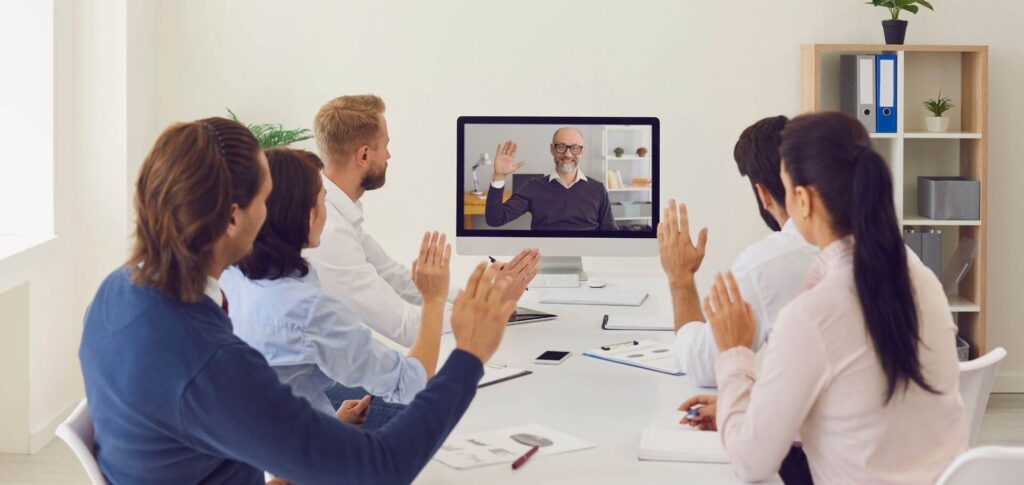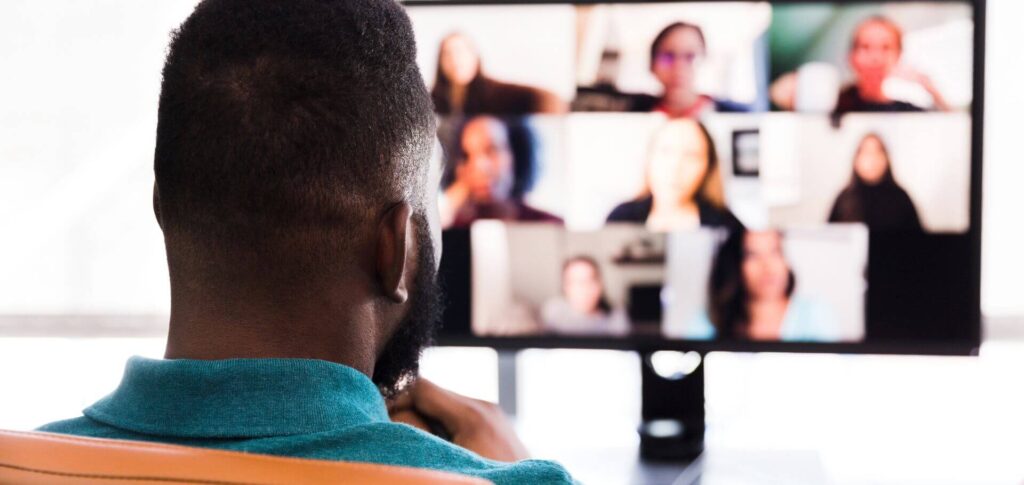Virtual Work
Rise of Virtual Work
Virtual work and virtual workplaces have been on the rise for several years now, and this trend has only accelerated in the wake of the COVID-19 pandemic. This has started a series of changes with virtual work and workplaces that are both cultural and structural. Many companies today are re-imagining business models and processes to keep pace with an ever-changing geo-political landscape.
In this article, we will explore the latest trends in virtual work and workplaces, look at the implications they have on the future of work and workplaces, and consider the opportunities this shift provides for the work of the gospel and expansion of God’s kingdom until his return.

Trends in Virtual Work
Virtual work can be seen as an extension of what Meta calls ‘extended reality’ (XR), an immersive, interconnected 3D world in which virtual reality, augmented reality, artificial intelligence, blockchain, and cryptocurrencies will redefine how we live, work and socialize.1
In the spirit of virtual work and the incorporation of artificial intelligence, we asked ChatGPT to contribute to our understanding of what some of these trends might be.
- Remote work: The pandemic has forced many companies to adopt remote work as a temporary measure. However, remote work was already a growing trend before the pandemic, and it is likely to continue in the post-pandemic world. This means that employees can work from anywhere in the world, which can result in greater flexibility and work-life balance.
- Virtual collaboration: As more people work remotely, collaboration tools like video conferencing, chat apps, and project management software have become essential. These tools allow teams to communicate and collaborate effectively, regardless of where they are located.
- Digital transformation: The move to virtual work has also led to a broader digital transformation in many industries. Companies are adopting new technologies to streamline processes, automate tasks, and improve efficiency. This includes cloud computing, artificial intelligence, and the internet of things (IoT).
- New business models: Virtual work has opened up new business models, such as the gig economy, where freelancers can work for multiple clients at the same time. This has also given rise to new platforms, such as Uber, Lyft, and Airbnb, that connect people with services and resources they need.
- Cybersecurity: As more work is done online, cybersecurity has become a major concern for companies. Cyber attacks have become more sophisticated, and companies need to take steps to protect their data and systems from breaches.2

Virtual Work as a Medium
Virtual work can be looked upon as a medium by which people can extend themselves to engage in work that, in the past, required physical presence. Virtual workspaces are thereby also extensions of physical workspaces. This is what Marshall McLuhan referenced when he coined the phrase ‘the medium is the message’.3
Using the ‘Four Laws of Media’ developed by McLuhan, one can explore the four aspects of virtual work and workspaces as a medium.
What does the medium enhance?
With the use of tools such as video conferencing, instant messaging, and collaborative software, people and teams can collaborate across vast distances, even working on one document simultaneously. This technology has collapsed space, distance, and time zones onto one’s device and screen. This application is relevant not only to workspaces, but also to virtual churches and virtual small groups, which enabled worship services and small groups to continue to ‘meet’ during the COVID-19 pandemic.
What does the medium make obsolete?
Virtual work has reduced the need for commuting to work and the demand for office space. Many office spaces have been vacated or repurposed in major cities. Some estimate that current office usage is at approximately 50 percent of pre-pandemic levels, which may become the new standard.4 This shift may bypass sectors such as healthcare, manufacturing, farming, and service-oriented industries which will continue to require physical presence.
The simple human interactions we used to take for granted—a pat on the back for a job well done, an affirmative glance across the hallway, chats by the coffee machine or in the lunchroom—are greatly restricted by virtual work. This lack of physical contact also complicates colleagues’ attempts to learn about each other’s culture and language.
According to a PEW research report for the U.S., the adoption of virtual or hybrid forms of worship and church as a result of the COVID-19 outbreak has not altered the share of adults who say they attend religious services in a given month, but it has dramatically shifted how they participate.5
What does the medium retrieve that had been rendered obsolete earlier?
As people were no longer required to commute extensively into cities for work, virtual work helped in some cases to bring about greater work-life balance. In previous generations and in some areas of the world today, the home has been a workplace for labour such as farming, carpentry etc. The industrial revolution and the growth of labour specialization brought many of these tasks out of the home, but virtual work has made the home a workplace again, albeit with different kinds of work. Pandemic lockdowns forced families to coexist in the home—working and schooling alongside each other (with varying degrees of success). This resulted in more family together time. It also encouraged a shift in expectations, whereby productivity could be measured by work outcomes rather than simply by hours clocked.
What does the medium become when taken to extremes?
As most of the work performed virtually is intellectual rather than physical, there will come a time when this work could well be replaced by artificial intelligence. There is a limit to the amount of time a human can spend on devices before becoming fatigued. Many during the COVID-19 pandemic experienced what is known as ‘Zoom fatigue’ after spending hours in video conferences and meetings. Post-pandemic, many were relieved to meet and collaborate with their colleagues again in the flesh. As beings who are social in nature, we crave in-person interactions. Virtual and/or remote work is fundamentally lacking in this essential area of human existence.

Do virtual spaces have space for all of us?
While the virtual world has the potential to bring people together in new and exciting ways, it is right for us to consider carefully if digital spaces are capable of accommodating all of us—both in terms of our populations and our nature.
Valuing the whole person
Humans are embodied beings, having what Jesus described as heart, mind, soul, and strength (Mark 12:30). Other than an intellectual presence, a person is also physical, emotional, and spiritual. Virtual work and workplaces separate the physical aspects, and the mediums of virtual conferences and collaboration software disable or severely limit conveyance of sympathy, apathy, and other emotional and spiritual aspects of a person.
Though various traditions take different perspectives on it, all generally agree that the theological concept of imago Dei includes humans as embodied beings. Jesus Christ, the Word made flesh (John 1), demonstrated and affirmed this embodiment, dispelling the Greek dualistic worldview that the physical body is corrupt and a source of temptation. Human personhood is inextricably physical and spiritual. For this reason, to the degree that virtual workplaces disregard the body or make it irrelevant, they dehumanize the person. A virtual world limits our senses. While devices may allow us to hear and see, we can at best see only a portion of the person through a camera, and sounds are mediated to us through technological filters. Current technology does not allow us to touch or smell, and even with future advances in technology, we can only hope for replicas of reality.6
With these limitations, what happens to relationships and bonds between people? In Genesis, humans were not only created for worship of God, they were also created for relationships and community. It is not good for man to be alone. Through anthropology and social science, we know that human beings are social beings that require interactions with people. For example, children who were socially isolated tended to have lower subsequent educational attainment, be in a less advantaged social class in adulthood, be psychologically distressed across adulthood, be obese, and smoke.7
How then can companies, social groups, and churches create a sense of community through the virtual medium? Jonathan Sacks wrote that there is an inherent ‘groupishness’ that lies at the heart of human identity: I am who I am because of the group or groups to which I belong. I am because we are. Against liberalism where the individual has no attachments to any group, the idea of an ‘unsituated self’ as Michael Sandel put it, is not true to life.8 Virtual work lacks the social interactions that naturally occur at a physical workplace, hindering community-building and adding to isolation.
Valuing all labour
During the COVID-19 pandemic, many governments imposed restrictions on movement in order to curb the spread of the virus. The global economy almost came to a halt, while people working in fields deemed ‘non-essential’ were told either to close or move to an online mode. Interestingly, many low wage, manual, and precarious types of work such as cleaning, nursing, food service and delivery, garbage collection, and supermarket store clerks were suddenly classified as ‘essential workers’, though the wages they received rarely reflected this valuable status.
If in our embrace of virtual work, we directly or indirectly devalue any occupation by which humans can glorify God by serving their fellow man, then we commit a grave error.
Our societies (including churches and Christian communities) have been influenced by a Greek dualistic worldview which favours intellectual work over manual work. Within our churches, this same dualism creates a divide between the sacred and the secular. However, Scripture bears no duality, whether between ancient and modern, eastern and western, faith and work, or charity and justice.
Human work is part of God’s good design in creation. God even portrays himself as a worker (Gen 1–2; John 5:17; Rev 21:5), specifically as shepherd (Ps 23), warrior (Exod 15:3), teacher (Ps 143:10; Prov 15:33), potter (Jer 18:6; Rom 9:20–21), and vinedresser (Isa 5:1–7; John 15:1–6).9 God welcomes the whole of our working lives within the sphere of ministry, as we serve God in different callings. If in our embrace of virtual work, we directly or indirectly devalue any occupation by which humans can glorify God by serving their fellow man, then we commit a grave error.
Attending to mental health
In a 2022 Gallup survey of US Employee Work Locations, about 49 percent of remote-capable employees were in hybrid mode. Exclusively remote work dropped from a peak of 70 percent at the height of COVID-19 to about 29 percent in Q2 of 2022. About a third preferred exclusively remote and two-thirds preferred hybrid, with only 6 percent preferring full onsite. Employees who don’t work in their preferred location have significantly lower employee engagement, alongside higher burnout and desire to quit. They simply do not feel well-positioned to do their best work or live their best life.10
Executives trying to get workers to return to the office say remote and hybrid work lead to social isolation, a sense of meaninglessness, and a lack of work-life boundaries. They cite numerous prominent articles, saying that remote work can lead to depression, substance abuse, and sedentary behaviour. While this may be true, it overlooks the many pitfalls that also accompany office-centric work.11
Ultimately, it is not the format of the workspace—either virtual or physical—but the culture of the organization and the environment it creates that fosters a sense of purposeful, meaningful, work and life. Any work environment can be stressful, anxiety-causing, and even toxic, leading to multiple mental health and other health issues. Consider the issues of mobbing at work, work culture such as 996 (9 a.m. to 9 p.m. six days a week), or phenomena such as karoshi (overwork death) or karojisatsu (overwork suicide). These exist in both virtual and office-based work.
Life-giving work cultures make space for physical and mental health. In the example of Jesus, he got up very early in the morning and went to a solitary place where he prayed (Mark 1:35). Believers must make time and space to be engaged in both the active and contemplative life—ora et labora (pray and work) which is a traditional slogan of the Benedictines. This practice promotes whole-person wellbeing.
Addressing access inequity
As exciting as it may be to imagine the possibilities for virtual work, the reality is not so bright, particularly for those who are left behind in the digital divide. COVID-19 was also dubbed the ‘inequality virus’ due to its contribution to widening the rich-poor gap. Several international studies have shown that the overarching effects of COVID-19 could deepen inequalities between rich and poor nations, between urban and rural populations, and between communities of different socioeconomic levels, age, gender, and colour.12 Around the world, a marked digital gap, both in access and in fluency exists along socioeconomic lines.13 In Argentina for example, 32 percent of households do not have a fixed internet access. In its least connected province, that number is as high as 68 percent.14
Life-giving work cultures make space for physical and mental health.
Though 93 percent of young people have mobile phones with internet, only 55 percent have computers. While five out of ten young people from the upper class use technology almost all the time at work, only one out of ten in the lower classes uses it. Taking into consideration that technological and scientific capacities are increasingly necessary in workplaces in almost every field, great efforts must be made to reduce this gap from the earliest years of education.
Addressing gender inequality
In addition to the digital divide, we must also address the gender divide. A 2019 International Monetary Fund report indicates that female workers are at a significantly higher risk for displacement by automation than male workers, with 11 percent of the female workforce at high risk of being automated given the current state of technology, albeit with significant cross-country heterogeneity. The probability of automation is lower for younger cohorts of women and for those in managerial positions.15 The pace of this shift has likely accelerated since the report’s publication.
The COVID-19 crisis and the rapid growth of teleworking generated a high-impact change in the lives of women. Some women benefited in the areas of childcare and domestic responsibilities, but this shift did not necessarily generate greater co-responsibility in household tasks, nor did it generate more egalitarian workplaces. Since the transition to remote work due to the pandemic, the mental health problems of women appear to have increased significantly over those of men as a result of the overload produced by balancing telework with unpaid labour, such as caring for children, the elderly, etc.16 It is highly necessary that organizations commit to preventing the exacerbation of gender disparity through telecommuting. Steps which may aid in this include:
- promoting equity in wages
- offering career development opportunities for both men and women
- providing support for families to pay for domestic helpers or childcare-related services
- establishing the right to disconnect
- generating networking spaces that allow teleworkers who could be disproportionately disadvantaged by virtual work to grow and develop their professional careers.
As Christians, we know that faith in Jesus makes each of us equal with each other (Gal 3:28). Re-thinking and reflecting on gender roles and their implications in families and social organizations can help reduce the gender gap at work and contribute to a better quality of life.

Big Brother Is Watching
Along with the rise in telework came another interesting phenomenon. Managers who were not used to having staff away from the office ended up monitoring staff by requiring them to turn on their device cameras even while they were home to ensure that they were working in front of their terminals and devices. This evokes images of George Orwell’s classic, Nineteen Eighty-Four, where ‘Big Brother is always watching you’.17 More sophisticated monitoring technologies take screenshots of employees’ laptops and give activity scores based on keyboard typing and mouse movement. A poll by the Trade Union Congress in 2022 found that 60 percent of employees had experienced tracking in the last year. Workers who are under surveillance report feeling exhausted by trying to reach employers’ productivity targets.18 Surveillance at work isn’t new, but when working virtually from home, such surveillance infringes on the personal space of workers and their families and further blurs the lines between work and personal space.
Leading and managing organizations virtually requires new attitudes and skill sets. We must re-design jobs and accountability mechanisms to assess work more by objectives met than by time spent and activity generated. We must also invest in building trust between workers and their supervisors, regardless of whether work is conducted in person or virtually. Generally, when employers lack trust, they have a negative or suspicious view of people’s motivation, and the resulting work environment is usually disastrous. The Apostle Paul offers an example of restoring trust when he reconciles Onesimus (a runaway slave who came to faith through Paul) to his Christian master Philemon. He also exhorts Christians to ‘Do nothing out of selfish ambition or vain conceit. Rather, in humility value others above yourselves, not looking to your own interest but each of you to the interests of the others’ (Phil 2:2-4).
Opportunities for the Gospel
Where then does this leave the work of the gospel and the church? Rather than rejecting virtual work or cyberspace for their possible ills, we can work to create work environments—virtual, in-person, and hybrid—that attend to the full needs of persons. These include:
- Helping those left behind by the digital gap to acquire skills that will help them to find jobs and adapt to this new reality. Faith-based ministries can reach out to digitally disadvantaged individuals to provide access, training, and job opportunities. In addition, local churches can also double up as vocational centres.
- Creating online communities where those affected by stress, anxiety, and isolation can be nudged to step out of their homes and into community, with the goal of fostering friendships and providing social and mental health support.
- Advocating for fair wages for ‘essential workers’ and narrowing the gender wage gap in our society. Unfortunately, some Christian business owners are seen to exploit low wage and/or female workers. Advocacy for fair wages can be done through raising these issues at unions, business associations, or chambers of commerce by prominent businessmen and women rather than by voices from outside business communities.
- Initiating or continuing to teach a theology of work in our churches that is biblically based and relevant, providing guidance for vocational calling at work. This leads to Christian spirituality that promotes work-life integration with a rhythm of active engagement and contemplative reflection.
- Building communities that reflect the kingdom of God. As the world moves away from this social necessity, Christian communities have a fresh opportunity to reflect the love of Christ through our love for one another (John 13:34–35).
Conclusion
What would Jesus say about our virtual work? Probably that we as humankind focus too much on efficiency and fall prey to the temptation to assume that we can do a lot more than what is realistic for a human being, given the physical and time limitations of each person. Virtual work does not necessarily change the nature of the work, the tasks performed, or the necessity for collaboration and serving other people. However, it does change the way and context in which work is being performed through the new medium of virtual workplaces. With more virtual work and workplaces (and more hybrid forms moving forward), what new cultures will emerge? Virtual work can be positive. The contributors to this article have collaborated entirely remotely from three different countries and two time zones. Perhaps it is time for Christians and churches around the world to, ‘reflect, re-think, re-group, re-envision, re-tool, and be fully ready to re-engage’19 in this new reality of virtual work and workplaces.
Endnotes
- “The future of the metaverse and Extended Reality.” KPMG. Accessed April 4, 2023. https://kpmg.com/xx/en/home/insights/2022/04/the-future-of-the-metaverse.html.
- Generated by ChatGPT on prompt “Describe trends in virtual work and workplaces”
- Marshall McLuhan. Understanding Media: The Extension of Man (New York, NY: Signet Books, 1964).
- Annie Erling Gofus. “Companies Look to Downsize Office Space as Remote Work Continues.” Global Workforce. March 23, 2023. https://www.worldwideerc.org/news/global-workforce/companies-look-to-downsize-office-space-as-remote-work-continues.
- Justin Nortey and Michael Rotolo. “How the Pandemic Has Affected Attendance at U.S. Religious Services.” Pew Research Center. March 28, 2023. https://www.pewresearch.org/religion/2023/03/28/how-the-pandemic-has-affected-attendance-at-u-s-religious-services/.
- Timothy Liu. “COVID Pandemic and Implications on Ecclesiology.” IMPACT Magazine. https://www.impact.com.sg/post/covid-pandemic-and-implications-on-ecclesiology.
- Rebecca E. Lacey, Meena Kumari, and Mel Bartley. “Social Isolation in Childhood and Adult Inflammation: Evidence from the National Child Development Study.” Psychoneuroendocrinology, 50, 85–94. https://doi.org/10.1016/j.psyneuen.2014.08.0074.
- Jonathan Sacks. Morality: Restoring the Common Good in Divided Times (New York, NY: Basic Books, 2020).
- Gordon Preece, Timothy Liu and Wong Siew Li,(ed.). “Lausanne Occasional Paper: Marketplace Ministry.” Lausanne Movement. 2004. https://lausanne.org/content/lop/marketplace-ministry-lop-40.
- Ben Wigert and Sangeeta Agrawal, “Returning to the Office: The Current, Preferred and Future State of Remote Work.” Gallup. August 31, 2022. https://www.gallup.com/workplace/397751/returning-office-current-preferred-future-state-remote-work.aspx.
- Gleb Tsipursky. “Does Remote Work Hurt Wellbeing and Work-Life Balance?” Forbes. Nov 1, 2022. https://www.forbes.com/sites/glebtsipursky/2022/11/01/does-remote-work-hurt-wellbeing-and-work-life-balance/?sh=234600ff4b20.
- Ng Jun Sen and Natasha Meah. “The Big Read: How COVID-19, dubbed the ‘inequality virus’, has further widened the rich-poor gap.” Channel News Asia. August 23, 2021. https://www.channelnewsasia.com/singapore/covid-19-inequality-virus-further-widened-rich-poor-gap-2127951.
- Marita Carballo. “Ricos y pobres: las razones de la brecha digital entre los jóvenes argentinos.” Clarin. June 4, 2018. https://www.clarin.com/opinion/ricos-pobres-razones-brecha-digital-jovenes-argentinos_0_S16SZaflQ.html.
- “32% of Argentine households without fixed Internet connection, says report.” Buenos Aires Times. November 6, 2021. https://www.batimes.com.ar/news/argentina/32-of-argentine-households-do-not-have-a-fixed-internet-connection-says-national-report.phtml.
- Mariya Brussevich, Era Dabla-Norris, and Salma Khalid. “Is Technology Widening the Gender Gap? Automation and the Future of Female Employment.” IMF. May 6, 2019.
- David Fang, Sonia K. Kang, Sarah Kaplan. “We need to make sure telecommuting does not exacerbate gender disparity.” The Lancet. July 11, 2022. https://doi.org/10.1016/S0140-6736(22)01211-9.
- George Orwell. Nineteen Eighty-Four (New York, NY: Signet Classics, 1949).
- Clea Skopeliti. “‘I feel constantly watched’: the employees working under surveillance.” The Guardian. May, 30, 2023. https://www.theguardian.com/money/2023/may/30/i-feel-constantly-watched-employees-working-under-surveillance-monitorig-software-productivity.
- Timothy Liu. “COVID Pandemic and Implications on Ecclesiology.” IMPACT Magazine.https://www.impact.com.sg/post/covid-pandemic-and-implications-on-ecclesiology.








